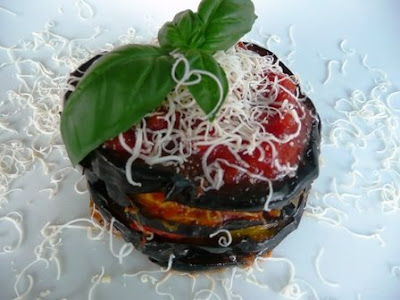
Yummy, yummy! It's time of one of my favourite dishes, eggplant Parmesan, also known as parmigiana di melanzane.
Despite its name, the word "parmigiana" does not derive from that of the Parmisan cheese but is the Italianization of the Sicilian dialectic word "parmiciana" which are the slats of wood composing the central part of a shutter and overlapping in the same manner as the slices of eggplant in the dish. It seems that parmigiana is a heritage of the Greek and Arab dominations in Sicily as it recalls the Greek moussaka and the Arab tiani.
It's way of cooking differs from area to area so, as usual, I post my family recipe.
Ingredients
serves 4 pax
4 medium/big size eggplants
200 gr pulped tomatoes
1 small onion
1 clove of garlic
2 eggs
100 gr of mortadella (or ham)
basil
salty ricotta cheese (or Parmesan)
extra-virgin olive oil
salt
1. Slice eggplants about half a centimeter thick (you should slice them lenghtways), pour eggplants in layers into a bowl filled with cold water covering each one with salt and let them rest for about 30 minutes. Then, stir and let them rest again for about 10 minutes on a dishcloth.
2. Use a frying pan, pour some olive oil and start frying the slices of eggplants on both sides until they get brown. Let each slice dry on a blotting paper.
3. Prepare the tomato sauce: cut the onion and the garlic finely up, pour some olive oil into a pan and brown them, then add pulped tomatoes and let everything cook for about 15 minutes until it thickens. Add salt and basil as you like.
4. In a oven-proof dish start arranging the fried slices of eggplants in layers and be careful not to place one on another if possible. Pour some tomato sauce along the first layer spreading it evenly and grate some salty ricotta cheese (or Parmesan). Add a new layer of eggplants and cover them with slices of mortadella or ham. Proceed with layers alternating one with tomato sauce and ricotta cheese/Parmesan with another with mortadella or ham until you reach 4 or 5 different layers.
5. Beat the eggs and cover with it the last layer of eggplants. Preheat the oven at 200°C for about 10 minutes, then put the parmigiana into the oven for about 30 minutes until the eggs get a brown ring.
6. You can serve it warm or better let it rest and serve cold. Before serving, you can decorate it with some tomato sauce, flakes of ricotta cheese/Parmesan and basil.
- use the long oval eggplant, dark purple in color, and be careful to choose the ones with the right consistency as they should be not too soft nor too hard
- to increase taste, you can add some mozzarella or caciocavallo cheese between layers
- grill the eggplants for a savour but light version of parmigiana but please, first cook it as per my recipe, you will taste (and appreciate!) the difference!
© Text and pictures by Doriana Briguglio
